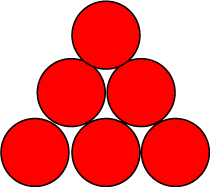Copyright © University of Cambridge. All rights reserved.
'Find the Difference' printed from https://nrich.maths.org/
Show menu
Why do this problem?
This problem is a challenging way of practising subtraction at the same time as being logical about arranging the numbers. The idea of 'difference' can be hard for children to grasp and this problem is an ideal way of coming to terms with it. You could also use this problem to focus on how children record their workings.
Possible approach
You could start by putting the numbers in any places in the pyramid and asking children to describe what they see. They may notice some accidental number patterns, but also which numbers are used. Then put two numbers into the pyramid, for example 4 and 5 in the bottom row, next to each other. Introduce the idea of the problem and invite pupils to suggest what number should go above the 4 and 5. You could repeat this a few times with different pairs of numbers so that children are happy with 'difference' and with the way the pyramid will be structured. You may need to emphasise that the smaller number will be taken away from the larger number each time.
Key questions
What do we need to do to find the difference between two numbers?
How will you keep track of what you have tried?
Possible extension
Possible support
Many children would benefit from using numbered counters that can be moved about if they don't have access to the interactivity. Some children may need to use manipulatives to support them in finding the differences.

 5 - 2 = 3
5 - 2 = 3